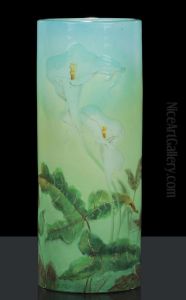Delphin Massier Paintings
Delphin Massier, born in 1836 in Vallauris, France, was a pivotal figure in the world of ceramic art, particularly renowned for his contributions to the revival of Majolica pottery during the late 19th and early 20th centuries. Vallauris, a small town in the Alpes-Maritimes department on the French Riviera, was already noted for its pottery thanks to the efforts of the Massier family, with whom the craft was synonymous. Delphin was part of a lineage of ceramicists; his grandfather, Pierre Massier, had started the family's involvement in pottery in the early 19th century, and it was among this environment of kilns and clay that Delphin's talent and passion for ceramics were nurtured.
Under the tutelage of his father, Clément Massier, Delphin honed his skills, showing an early aptitude for the family craft. However, it was his innovation and artistic flair that set him apart. Delphin Massier is particularly famed for his work in Majolica, a type of pottery that uses a tin glaze that has been painted and fired to vibrant effect. He was instrumental in the revival of this technique, which had its roots in the Italian Renaissance, adapting it to reflect the Art Nouveau tastes of the late 19th century.
Massier's creations often featured naturalistic themes, including a wide variety of flora and fauna, with iridescent glazes that became a hallmark of his work. His vases, jardinières, and decorative plates were not only popular in France but also gained international acclaim, contributing significantly to the prestige of Vallauris as a center of ceramic art. Delphin Massier also explored the use of metallic lusters in his pottery, a technique that added a shimmering, reflective quality to the surface of his pieces, further distinguishing his work from that of his contemporaries.
Throughout his career, Delphin Massier collaborated with other artists and was part of the broader artistic movements of his time. His works were exhibited in numerous international expositions, including the Paris Exposition Universelle of 1889, where the artistry of Massier ceramics received widespread recognition. Despite the industrialization of pottery production during his lifetime, Massier maintained a commitment to craftsmanship and artistic integrity, ensuring that each piece was a testament to the skill of its creator.
Delphin Massier passed away in 1907, leaving behind a rich legacy that continued through his descendants and the many artists he influenced. Today, his works are highly prized by collectors and can be found in museums around the world, celebrated for their innovation, beauty, and the pivotal role they played in the revival and transformation of ceramic art at the turn of the century.
